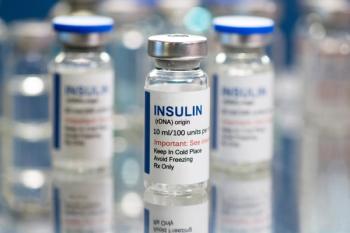
The ABCs of Insulin
Insulin therapy must be individualized and balanced with meal planning and exercise.
Insulin is a naturally occurring hormone produced by the pancreas. Insulin is required to move sugar from the blood into the body’s cells, where it can be used for energy. For the symptoms of high blood sugar and low blood sugar, see Tables 1 and 2.
Type 1 diabetes (T1D) is a chronic condition in which the pancreas produces little or no insulin. Only 5% of patients with diabetes have this form of the disease, according to the American Diabetes Association.
Type 2 diabetes (T2D) is much more common; the risk factors are listed in online table 3. Individuals with T2D make insulin, but their bodies don’t respond well to it, a condition known as insulin resistance. Treatment of T2D usually begins with dietary and lifestyle changes, as well as oral medications. Over time, as the pancreas struggles to make an adequate amount of insulin to overcome insulin resistance, patients may require insulin supplementation.
Insulin therapy must be individualized and balanced with meal planning and exercise. When a patient begins using insulin to manage diabetes, the initial dose is just a starting point. Over time, insulin requirements are affected by factors such as weight gain or loss, changes in eating habits, and the addition of other medications. The need for insulin often increases, and the dose must be readjusted to meet the new requirements.
Insulin is injected subcutaneously, meaning not very deep under the skin. Common injection sites include the stomach, buttocks, thighs, and upper arms. By rotating the site of injection, patients can avoid lipohypertrophy, a slight increase in the growth or size of fat cells under the skin. When lipohypertrophy occurs, a soft pillowy growth may form at the repeated-use injection site. Therefore, for reliable absorption rates and cosmetic purposes, it’s important to rotate insulin injection sites.
TYPES OF INSULIN
Insulin types vary depending on how quickly they work, when they peak, and how long they last. As sliding-scale insulin therapy has fallen out of favor, many experts recommend using basal insulin with mealtime insulin added when needed. Basal insulin is intended to keep blood glucose levels under control during periods of fasting or sleep.
The 2 main types of basal insulin are intermediate- acting insulin and long-acting insulin. To mimic the way the body of a patient without diabetes releases insulin, bolus insulin (short-acting or rapid-acting insulin) must be administered to prevent an increase in the blood glucose level after meals.
Regular or short-acting insulin (Humulin R; Novolin R; and, for insulin pump, Velosulin):
- Taken at mealtime
- Begins to work in 30 minutes
- Peaks in 2 to 3 hours
- Effects last up to 6 hours
- Neutral protamine Hagedorn (NPH) insulin must be resuspended (gently mixed by rolling) before use
Rapid-acting insulin (glulisine, lispro, and aspart):
- Taken at mealtime
- Begins to work in 15 minutes
- Peaks in about 1 hour
- Effects last up to 4 hours
Intermediate-acting insulin (NPH, Humulin N, and Novolin N):
- Taken once daily
- Peaks 4 to 8 hours after injection
- Effects last up to 18 hours
- If injected at bedtime, it will likely peak at predawn hours when needed most
Long-acting insulin (detemir [Levemir] and glargine [Lantus]):
- Evenly lowers glucose levels
- Effects can last up to 24 hours
Ultralong-acting insulin (degludec [Tresiba]):
- Taken once daily
- Effects can last more than 24 hours
Premixed insulins combine specific amounts of intermediate-acting and short-acting insulin in 1 bottle or insulin pen. These products, which include Humulin 70/30, Novolin 70/30, Novolog 70/30, Humulin 50/50, and Humalog Mix 75/25, are generally taken 2 or 3 times a day before mealtime.
Table 3. Type 2 Diabetes Risk Factors
Overweight and obesity
Physical inactivity
Family history
Genetics
Race and ethnicity
Age
High blood pressure
Abnormal cholesterol
INSULIN STRENGTHS AND SYRINGES
Insulin is available in several strengths, although most insulin sold in the United States is U100, meaning there are 100 units of insulin in every milliliter of liquid. A 10-mL bottle of U100 insulin contains 1000 units of insulin. There are 3 sizes of U100 insulin syringes: 1/3 cc, 1/2 cc, and 1 cc. A 1/3-cc syringe holds 30 units of insulin, 1/2 cc holds 50 units, and 1 cc holds 100 units. The type of syringe used depends on how much insulin is required.
Several new insulins with concentrations greater than U100 have recently come to the market. These products were developed for individuals requiring large doses of insulin in order to reduce the volume injected and the number of injections. Toujeo (insulin glargine [rDNA origin]), a once-daily, long-acting basal insulin, contains 300 units/mL (U300). For patients with severe insulin resistance in need of more than 200 units/day, superconcentrated U500 insulin is available.
INSULIN DELIVERY SYSTEMS
A variety of insulin delivery systems exist, including syringes, insulin pens (disposable and reusable), needle-free jet injectors using very high pressure to push a fine spray of insulin through the skin, and inhaled insulin. Insulin pumps deliver the insulin the body needs 24 hours a day through a catheter placed under the skin. Although these devices have been used to treat T1D for about 35 years, their use has become widespread in only the past 15 years.
All NPH insulin, as well as lente and ultralente (all cloudy insulins), need to be mixed to ensure uniform suspension of the insulin within the liquid. To ensure its effectiveness and to decrease blood glucose fluctuations, be sure to properly mix your insulin by turning the bottle over from end to end a few times, or by rolling the bottle gently between the palms of the hands.
INSULIN STORAGE
Unopened insulin should be stored in the refrigerator until needed and may be used until the printed expiration date on the label. Never allow insulin to freeze and do not expose it to heat or direct sunlight. Once in use, insulin vials can be stored at room temperature. Room temperature insulin is less likely to cause pain when injected. Generally, most vials of insulin are good for 28 days. Disposable pens should be stored at room temperature once in use and are good for 10, 14, 28, or 42 days, depending on the type of insulin. Check the medication insert, and follow the manufacturer’s guidelines.
END NOTE
Insulin is not a cure for diabetes, but if used appropriately and with proper diet and physical activity, it can help to control diabetes and lower the risk of complications.
RECOMMENDED READING
- Diabetes basics. American Diabetes Association website. diabetes .org. Accessed August 28, 2016.
- Diabetes treatment: using insulin to manage blood sugar. Mayo Clinic website. mayoclinic.org/diseases-conditions/diabetes/in-depth/ diabetes-treatment/art-20044084. Accessed August 28, 2016.
Beth is a clinical pharmacist and medical editor residing in northern California.
Newsletter
Stay informed on drug updates, treatment guidelines, and pharmacy practice trends—subscribe to Pharmacy Times for weekly clinical insights.













































































































































































































